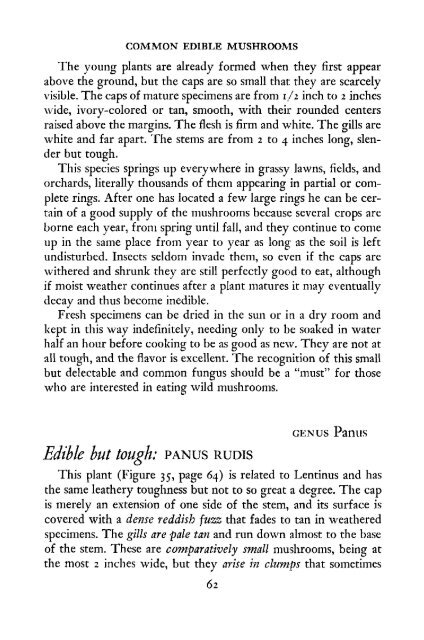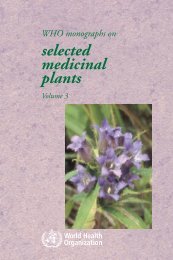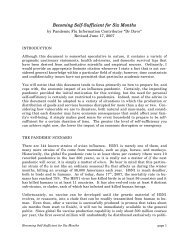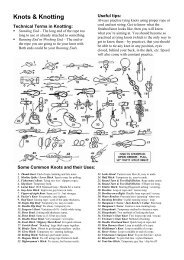Create successful ePaper yourself
Turn your PDF publications into a flip-book with our unique Google optimized e-Paper software.
COMMON EDIBLE MUSHROOMS<br />
The young plants are already formed when they first appear<br />
above the ground, but the caps are so small that they are scarcely<br />
visible. The caps of mature specimens are from 1/2 inch to 2 inches<br />
wide, ivory-colored or tan, smooth, with their rounded centers<br />
raised above the margins. The flesh is firm and white. The gills are<br />
white and far apart. The stems are from 2 to 4 inches long, slender<br />
but tough.<br />
This species springs up everywhere in grassy lawns, fields, and<br />
orchards, literally thousands of them appearing in partial or complete<br />
rings. After one has located a few large rings he can be certain<br />
of a good supply of the mushrooms because several crops are<br />
borne each year, from spring until fall, and they continue to come<br />
up in the same place from year to year as long as the soil is left<br />
undisturbed. Insects seldom invade them, so even if the caps are<br />
withered and shrunk they are still perfectly good to eat, although<br />
if moist weather continues after a plant matures it may eventually<br />
decay and thus become inedible.<br />
Fresh specimens can be dried in the sun or in a dry room and<br />
kept in this way indefinitely, needing only to be soaked in water<br />
half an hour before cooking to be as good as new. They are not at<br />
all tough, and the flavor is excellent. The recognition of this small<br />
but delectable and common fungus should be a "must" for those<br />
who are interested in eating wild mushrooms.<br />
GENUS Panus<br />
<strong>Edible</strong> but tough: PANUS RUDIS<br />
This plant (Figure 35, page 64) is related to Lentinus and has<br />
the same leathery toughness but not to so great a degree. The cap<br />
is merely an extension of one side of the stem, and its surface is<br />
covered with a dense reddish -fuzz that fades to tan in weathered<br />
specimens. The gills are pale tan and run down almost to the base<br />
of the stem. These are comparatively small mushrooms, being at<br />
the most 2 inches wide, but they arise in clumps that sometimes<br />
62
















